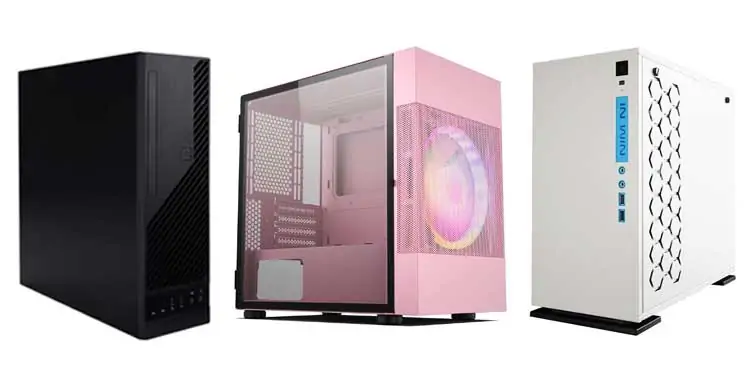There are a plethora of reasons why you’d want to go for a small Micro ATX case in 2022. Maybe you’re on a tight budget and want to go for a reasonable Micro ATX motherboard.
Or perhaps you have a small setup and want a space-efficient PC without paying the premium that Mini ITX cases and components demand.
No matter the reason, you’ll benefit from the know-how of the best Micro ATX cases available in the market today.
I’ve done the arduous legwork for you and came up with great cases for varying budget levels and all types of unique workloads..
Smallest Micro ATX Case Overview
[table id=406 /]
Before You Buy: Top 3 Features to Look Out For
Before you go ahead and commit to purchasing a small Micro ATX case, here are three points you should keep in mind to ensure a smooth user experience:
Durable Build Quality
Build quality is often neglected by most buyers, but it’s an essential factor for long-term use, and especially important with small Micro ATX cases. With every component, like the GPU and the AIO cooler, huddled together closely, you definitely want a case that has the solid build quality to avoid any mishaps.
Good build quality usually comes down to less flimsy plastic parts, more aluminum, and proper painting treatment as well. This will guarantee that your case will last through thick and thin.
Airflow
Airflow generally isn’t an issue in standard full-size ATX cases. However, when it comes to smaller Micro ATX cases, it can become a huge bottleneck. The case might have the space to pack all the latest high-end components, but they won’t be any good to you if they’re choking for air.
This is something known as “thermal throttling” and it happens when a component, like a GPU, can’t perform optimally because it’s getting overheated due to lack of airflow.
The way to avoid thermal throttling is to get a case with sufficient airflow. To be more specific, one with dust filters and vented or mesh side panels.
This will ensure that the components get the required airflow to perform at 100%. I’ll discuss this topic in greater depth in each review.
PSU Shroud
When it comes to small Micro ATX builds, cable management can be a huge challenge. You’re working with a small enclosure as it is, but then you also have all these pesky cables to hide. So, it’s important to buy a case that has user-friendly features.
A PSU shroud is a compartment at the bottom of the case which enables you to hide loose cables as well as the PSU inside a clean enclosure. They’re useful for cable management purposes, especially if you’re using a non-modular PSU.
Without it, the leftover PSU and SATA cables along with the drive cages will significantly lower the cleanliness of the build. Although it’s possible to create your own DIY PSU shroud, for the sake of simplicity it’s just better to get a case that has one from the get-go.
Besides these three, there are some other points to remember as well, like RGB and aesthetics, component compatibility, and total value for price. With this in mind, let’s go ahead and look at some of the best small Micro ATX cases available in 2022…
Best Micro ATX Cases
Cooler Master MasterBox NR400 – Best Overall Smallest Micro ATX Case
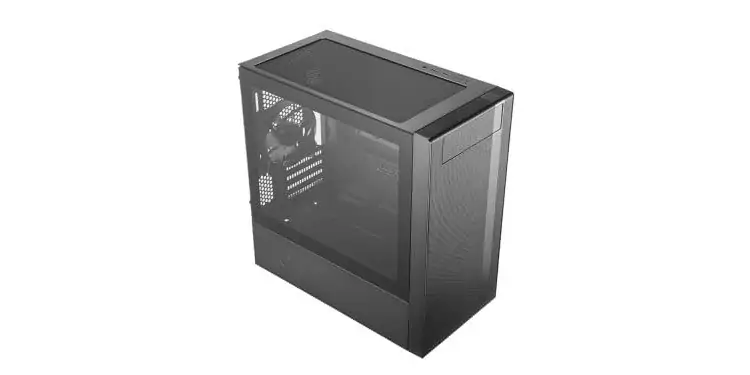
Key Specifications
- Form Factor: Micro ATX
- Front I/O: 2x USB 3.0 and Audio In/Out
- Expansion Slots: 4
- Integrated RGB Lighting: No
- Fans Included: 2x 120mm
Before we get into various categories, let’s talk about the best Micro ATX case overall. For me, it has to be the Cooler Master MasterBox NR400. I consider it to be an all-around great case with a strong focus on airflow along with plenty of room to meet the hardware and storage demands of any general user.
The best feature of the NR400 is the ample storage drive mounting space. There are four 2.5” and 3.5” drive mounting locations each. Three of those 3.5” drives are stored in a drive cage under the PSU shroud and can be moved or removed as necessary.
The US version of the NR400 even comes with an optical drive bay, which you’ll definitely appreciate if you’re into physical media content. When it comes to fans, this case comes with two 120mm fans, intake, and exhaust. This, combined with the mesh panels, gives the NR400 great cooling performance.
All in all, it’s a powerful combo of wallet-friendly pricing and impressive thermals that makes the Cooler Master MasterBox NR400 the best Micro ATX case in my book.
- Ample storage drive mounting space
- Impressive thermals
- US version comes with an optical drive bay
- Mediocre build quality
In Win CJ712 – Slimmest Micro ATX Case with Power Supply
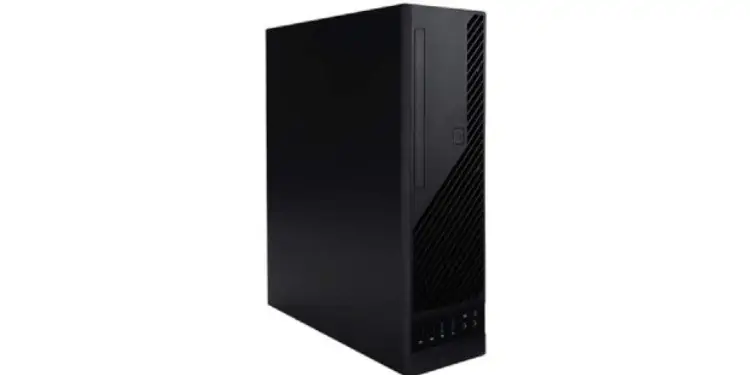
Key Specifications
- Form Factor: Micro ATX
- Front I/O: 2x USB 3.0, 2x USB 2.0, Audio, and Mic
- Expansion Slots: 4
- Integrated RGB Lighting: No
- Fans Included: 1 x 80mm
If you’re looking for a slim and small Micro ATX case that is optimal for both horizontal and vertical orientations, the In Win CJ712 is a good pick. It’s perfect if you’re building a backup PC you’d like to place in a corner away from your main setup.
This case even comes with a 265W power supply unit built-in! While this isn’t enough for high-end components, it could be great for a low-power backup system or a home theater system for content consumption and mid-range gaming. When it comes to drive bays, it has space for two 2.5″ SSDs or one 3.5″ and one 2.5″, which should be enough for most users.
Overall, the In Win CJ712 is a great Micro ATX case for the purpose of building a backup PC or home theater system. It can easily be hidden away behind a TV or on a shelf for clean looks and is a great self-contained case.
- Budget-friendly price point
- Optional optical disk tray for physical media
- Perfect for backup or home theater system
- Can only accommodate low-profile coolers
Thermaltake Versa H18 – Best Budget Micro ATX Case
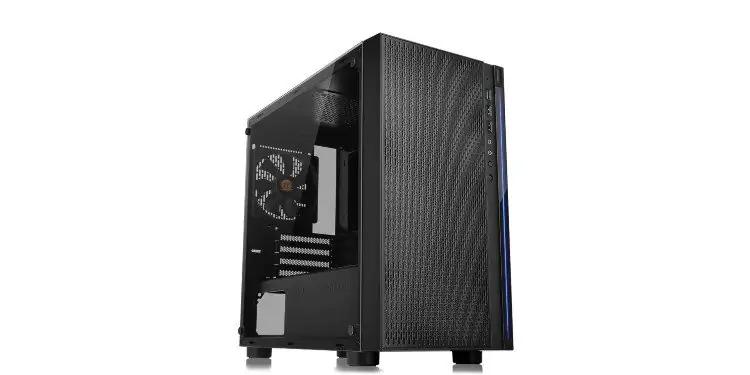
Key Specifications
- Form Factor: Micro ATX
- Front I/O: 1x USB 3.0, 2x USB 2.0, and Audio In/Out
- Expansion Slots: 4
- Integrated RGB Lighting: No
- Fans Included: 1x Rear 120mm
While all these cases on this list are value-packed, if you’re looking for a budget-friendly and Small Micro ATX case for around $50, the Thermaltake Versa H18 should be considered as a great option. It might have a highly aggressive price point, but the compromises made to reach it aren’t total deal-breakers for most users.
You still get an impressive front panel made with mesh material that is airflow-friendly. You also get plenty of space to install either two 140mm or three 120mm intakes. You can even pack a 280mm radiator in this case, which isn’t a bad option at all.
One disappointment is that it only comes with a single exhaust fan out of the box. I’d recommend adding a minimum of one extra intake fan to create a positive airflow cycle. However, thanks to the mesh panel, it’s not absolutely necessary for general use-cases.
Another aspect in which this case stands back in comparison to others on this list is build quality. The thin side panels and overall lightweight feel make it less premium, but considering the price point, I don’t really think this is a big issue.
If you’re planning on building a beast PC, I’d recommend you go with a case like the Cooler Master MasterBox NR400 instead. However, if you’re looking for something cheap for a low-end system and have some 120mm fans on hand, the Thermaltake Versa H18 won’t burn a hole in your pocket and will still look awesome!
- Impressive budget-friendly pricing
- Decent build quality
- Mesh panel and open interior layout
- Comes with only one exhaust fan
In Win 301 – Best Micro ATX Gaming Case
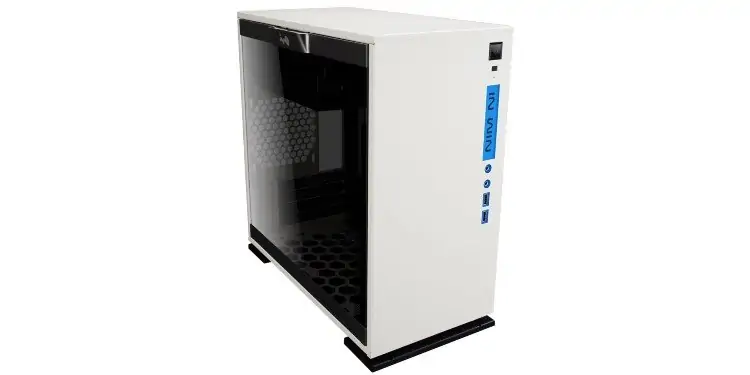
Key Specifications
- Form Factor: Micro ATX
- Front I/O: 2x USB 3.0 and Audio In/Out
- Expansion Slots: 4
- Integrated RGB Lighting: Yes
- Fans Included: None
The In Win 301 has all the features of a regular Micro ATX case, except the supercool white and blue color theme that sets it apart from the pack, along with the tempered glass panel, closed front panel, and RGB LEDs behind the I/O port. This makes it perfect for a chill gaming setup.
It also has a lot to offer outside of unique aesthetics, however. It has removable push tabs for cable management, a bottom dust filter, and a built-in GPU support bracket. These tiny features, along with others, combine to make this a great case for gaming.
With all that being said, there’s one caveat about the sub-$100 price point of the 301. It doesn’t ship with any stock fans included. This isn’t a big loss by itself if you’re planning to use your own fans anyway, but if you don’t have any on hand, then it can be an extra overhead cost since you’ll need to order extra ones to add in the case.
Another point to note is storage. In the 301, you get dual 2.5” drive mounting points along with one combo 2.5” and 3.5” point. This kind of setup is more reminiscent of Mini ITX cases rather than Micro ATX cases. Don’t get me wrong, it’s still more than enough for a gaming PC, but if you’re a professional content creator, you might need to pay extra for high-capacity SSDs.
Overall, despite there being zero fans out of the box and a mediocre amount of drive bays, I would still highly recommend the In Win 301 for any micro ATX gaming PC build. In terms of design, it looks awesome in white, and it also has great cable management features and fairly good airflow too.
- Impressive design and aesthetics
- Budget-friendly pricing
- Multiple cable management features
- Mediocre number of drive bays
Corsair Crystal 280X – White Micro ATX Case
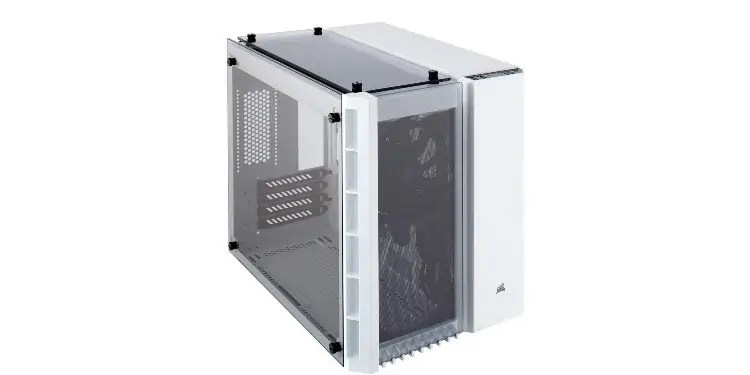
Key Specifications
- Form Factor: Micro ATX
- Front I/O: 2x USB 3.0 and Audio In/Out
- Expansion Slots: 4
- Integrated RGB Lighting: Yes
- Fans Included: 2x Front 120mm
Unlike the last case, if you’re developing an all-white gaming setup, the Corsair Crystal 280X might be the perfect option to go for.
One of the unique features of this case is that it has a dual-chamber design. Basically, it separates the PSU and drive bays from heat-generating devices which need active cooling, like the CPU and GPU. This improves the overall airflow and cooling performance and can lead to better overclocks and a smoother user experience too.
The Corsair Crystal 280X is also equipped with iCUE and has a tempered glass side panel to show off your beautiful RGB components. For that purpose, Corsair includes two LL120 fans in the box too. These fans pack over 32 individually programmable LEDs.
Everything considered, if you’re looking for a small white Micro ATX case, this is one of the best you can get. It not only looks amazing but has impressive cooling performance too.
- iCUE compatibility
- Two LL120 RGB fans included
- Dual-chamber design for better airflow to CPU and GPU
- Overpriced
Thermaltake Core V21 – Best Micro ATX for NAS Build
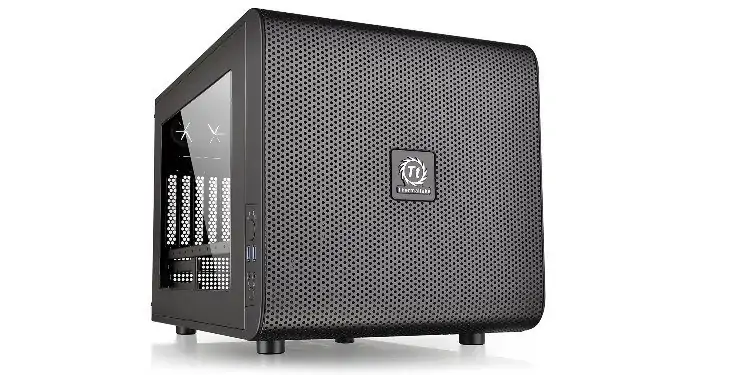
Key Specifications
- Form Factor: Micro ATX
- Front I/O: 2x USB 3.0, Audio, and Mic
- Expansion Slots: 5
- Integrated RGB Lighting: No
- Fans Included: 1x Front 200mm
Most regular cases aren’t suitable for NAS (Network Attached Storage) builds. While technically you can build one if you have the necessary space, they are usually overkill for that specific purpose and stand out too much. A perfect NAS case is one that is budget-friendly and has minimal looks. I present to you the Thermaltake Core V21!
Similar to the Corsair Crystal 280X, this case has a chamber concept design. It has been divided into two parts: the upper area dedicated to cooling components and the lower one for PSU and storage drives. Along with better cooling, this also ensures easy cable management.
One unique feature of this case is that it is externally modular. This means that you can keep stacking one Thermaltake Core V21 on top of another to multiply space and increase the capabilities of the NAS system. This is definitely a handy feature if you want to start with a relatively small system and then increase storage capacity over the long term as needed.
At the end of the day, this case is perfect for NAS builds and not much else. If you’re looking to build a gaming PC, look at the other cases on this list instead. However, for your superfast network-attached storage system, definitely keep this one in mind!
- Perfect for NAS system
- Budget-friendly price point
- Decent build quality
- Only one pre-installed fan
Vetroo M01 Compact – Pink Micro ATX case
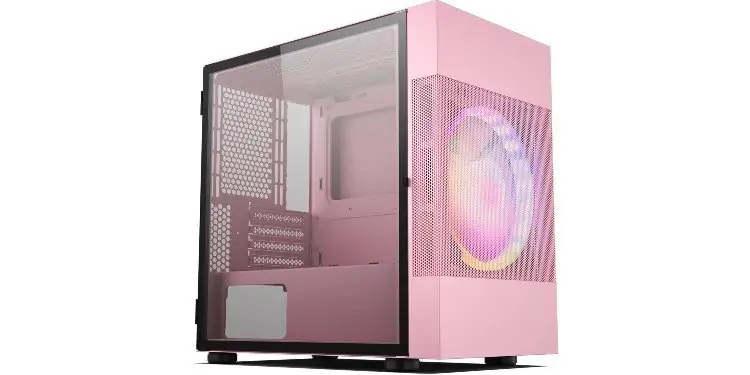
Key Specifications
- Form Factor: Micro ATX
- Front I/O: LED Control, 1x USB 3.0, 2x USB 2.0, and HD Audio In
- Expansion Slots: 3
- Integrated RGB Lighting: Yes
- Fans Included: 1x Front 200mm
When looking for pink-colored components, your options tend to be pretty slim since it’s a unique color and only suitable for a certain niche of users. Fortunately, if you’re looking for a small pink Micro ATX case, the Vetroo M01 Compact is a great option.
When it comes to design, the front 200mm static rainbow fan has LEDs in it for cool aesthetics. Plus, since the front panel is made of fine mesh, you also get decent airflow, although I’d recommend adding some extra exhaust fans. That shouldn’t be a problem since this case supports up to five fans and a max 280mm AIO radiator.
To summarize, the Vetroo M01 Compact is an impressive pink PC case. Most manufacturers don’t use pink for their products, so your options are limited, but this is a solid choice nonetheless. So, if you’re looking for a small pink Micro ATX case, you can end your search with this one!
- Supports GPU up to 340mm in length
- Great build quality
- Impressive aesthetics
- Slightly overpriced
Fractal Design Meshify C Mini – Best Airflow Micro ATX Case
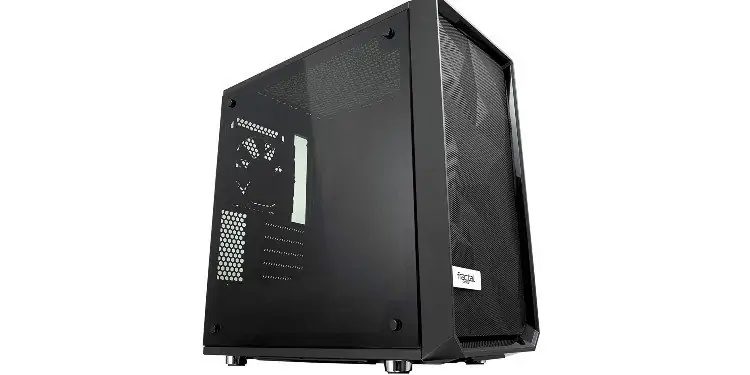
Key Specifications
- Form Factor: Micro ATX
- Front I/O: 2x USB 3.0 and Audio In/Out
- Expansion Slots: 5
- Integrated RGB Lighting: No
- Fans Included: 2x 120mm
As I said in the Before You Buy section, airflow is essential for any PC to run optimally. If there isn’t sufficient airflow, the components choke for air. This is something known as “thermal throttling” and it happens when a component can’t perform at 100% because it’s constantly getting overheated.
With that in mind, the best airflow Micro ATX case is the Fractal Design Meshify C Mini. It’s the Micro ATX offering in the company’s Meshify line-up of airflow-focused cases. In it, you not only get support for up to seven 120mm fans but also two 240mm AIO radiators in the front and top.
This, in addition to the vented upper panel and mesh front panel, ensures that the components get the required airflow to perform at 100%. To conclude, if you want a premium-feeling small Micro ATX case with solid thermals and don’t mind paying extra, the Fractal Design Meshify C Mini is the right choice.
- Impressive airflow and thermals
- Great build quality
- Useful front I/O configuration
- Overpriced
ZZAW B3 Portable mATX – Best Micro ATX Case for Portability
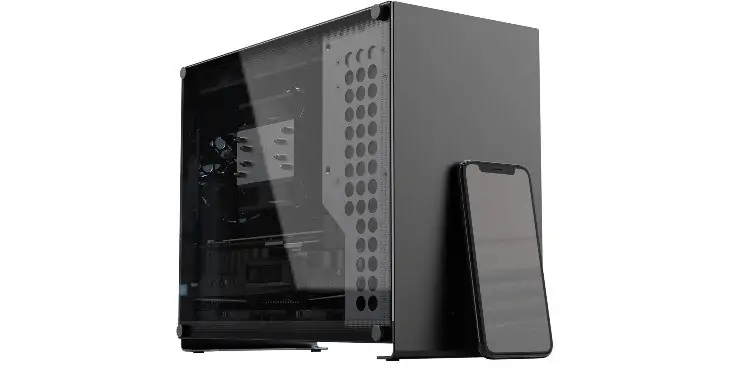
Key Specifications
- Form Factor: Micro ATX
- Front I/O: 1x USB 3.0
- Expansion Slots: 3
- Integrated RGB Lighting: No
- Fans Included: None
Anybody building a small form factor PC has probably thought of portability at one point or another. These cases not only provide the sturdiness required for portability, but the smaller footprint makes them easier to carry around too. If that’s your main reason behind going for a small Micro ATX case, the ZZAW B3 is a great choice.
It has a minimalistic and modern design that will fit right into most setups without any problems. It’s also highly durable, made of an aluminum-magnesium alloy sheet. The side tempered glass panel also gives a good view into the system, especially if you have RGB components.
When it comes to cooling, the vented top panel will definitely help with the airflow. For your cooling components, you have the option to install up to three 120mm fans and a bunch of smaller 90mm ones. Alternatively, you can also install a 240mm AIO with 54mm radiator clearance. For the CPU cooler, anything below 138mm like the Noctua NH-U9S should work.
All in all, if you want a small and portable Micro ATX PC that you can easily carry to gaming tournaments, hackathons, and LAN parties, the ZZAW B3 is the right choice to go for.
- Support triple-slot graphics card
- Offers great portability features
- Durable build quality
- Doesn’t come with any pre-installed fans
Thermaltake Level 20 VT – Micro ATX Open Case
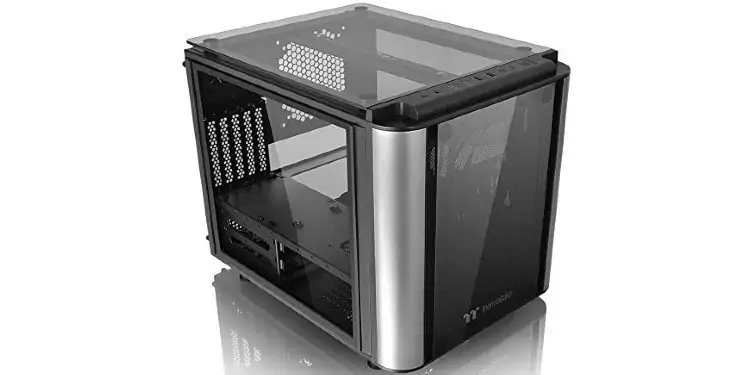
Key Specifications
- Form Factor: Micro ATX
- Front I/O: 2x USB 3.0, 2x USB 2.0, and Audio In/Out
- Expansion Slots: 5
- Integrated RGB Lighting: No
- Fans Included: 1x Front 200mm
If you’re bored with all the tried-and-tested designs out there and want to experiment a little with your setup, an open cube case like the Thermaltake Level 20 VT is a solid option to go for. As you can see, it has tempered glass panels all around, which makes it great for showcasing your RGB components seamlessly.
Plus, each panel can be swapped. This means that, according to your requirements, you can place the case on any of its sides however you want. Even the front I/O panel can be unscrewed and moved to the top, left, or right side of the case!
Another big feature is the ample amount of space it offers for fans and AIO radiators. Out of the box, you only get a single 200mm intake fan. But, you have the option to load the top panel with up to four 120mm fans or dual radiators at the same time.
Unfortunately, the design which makes it so unique also blocks airflow. There are no mesh or vented panels, so you’re only relying on the cuts between each panel for air. However, if you’re using a solid cooling system like a 240mm AIO it shouldn’t be a huge bottleneck.
Overall, the Thermaltake Level 20 VT is a very unique and eye-catching small Micro ATX case. If you can overlook the mediocre airflow configuration, it can be a great addition to your gaming setup!
- Modular panels for customization
- Impressive front I/O configuration
- Plenty of expansion slots
- Only a single intake fan included
Can I Fit Full-Sized GPUs Into My Case?
For the most part, yes.
While Micro ATX and Mini ITX Cases are both focused on providing PCs with smaller form factors, Micro ATX serves as more of a middle-ground between ATX and ITX. This means that most full-sized GPUs (10 inches or shorter) will fit into most Micro ATX cases just fine, often with room to spare.
However, some longer GPUs, especially triple-fan designs, may not fit as neatly. If you’re uncertain that your GPU will fit inside your case of choice, just play it safe and find out what your case’s clearance actually is.
Will My Components Have Enough Cooling?
If you go with one of the cases we’ve recommended, yes.
All of the cases that we’ve recommended above have great thermal performance and airflow. As long as you aren’t running a nuclear reactor inside one of them, your temperatures should be very manageable. A high-efficiency PSU and a liquid cooling setup reduce your temperatures even further.
Do I Need Liquid Cooling?
No, but it is highly recommended for smaller PC builds.
The basic components of a closed-loop liquid cooling system are its radiator, which usually takes the place of two case fans, its tubing, and the cooler that you actually mount against your CPU. Since all of the heat is being exhausted through the radiator, the cooler that connects to the CPU is very low-profile, moreso than any air cooler could hope to be.
Since most MATX and ITX cases have a thinner width and room for mounting a radiator, liquid cooling setups are particularly ideal. They are not a necessity, however- if you want air cooling, you’ll just need to get one with a smaller heatsink.
What Compromises Should I Expect in a Smaller Case?
Aside from the aforementioned air cooler issue, not as many as you might expect.
Most popular MATX and ITX cases are made with full-sized GPUs in mind, for instance. As long as you’re buying GPUs that aren’t overly-massive, you likely won’t have any issues.
The main compromises are with multiple GPU setups and multiple hard drives. Fortunately, the former is generally obsolete, so you won’t be losing too much by forgoing it. Multiple hard drives are useful, however, and your average M-ATX case won’t have room for mounting more than a few.
As long as you aren’t running an SLI or RAID setup from your MATX or ITX case, you should be just fine.
Conclusion
The days of Micro ATX builds needing to be big and bulky to house high-end and powerful components are long gone. This list of the best small mATX cases stands as proof that it’s possible to experience all the features of an mATX motherboard while still slimming down on the space your PC requires.
As with most components like GPUs, PSUs, and CPUs, there’s no blanket recommendation to be made here either. Each case will suit a unique type of user based on their specific requirements. It’ll boil down to your design tastes, budget level, and the features you’re willing to let go to use a smaller form factor. I hope my article guided you in the right direction!

